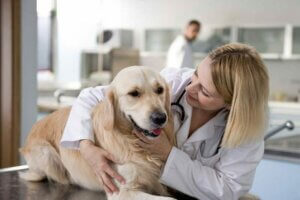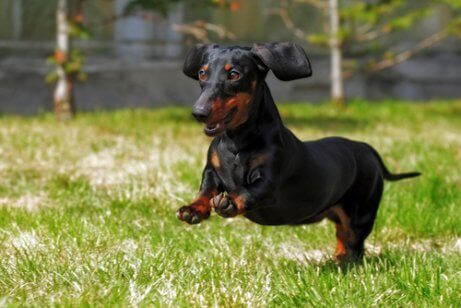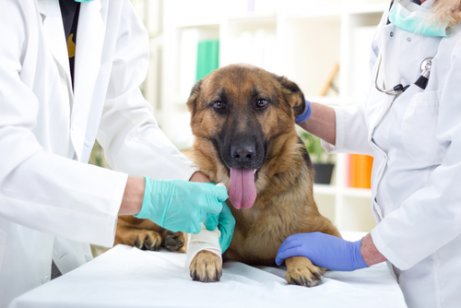Canine Achondroplasia: Symptoms and Treatments

When a dog’s legs are too short, so much so that it might have dwarfism, it’s very likely that we’re dealing with canine achondroplasia. This condition is inherited and it can affect the animals that suffer from it to varying degrees. In this article, we’ll tell you everything you need to know about canine achondroplasia and its symptoms and treatment.
Breeds that are most likely to have canine achondroplasia
This condition is a form of osteochondrodysplasia that’s caused by an abnormality in the fibroblast growth receptor gene. So, what happens? When animals suffer from this condition, their bones don’t grow to the expected size, regardless of the animals’ sex.
There are some breeds that humans have decided should continue to have this short-limbed trait. It’s a deeply debated subject, but we won’t be discussing that in this article. Here are some examples of dogs that are bred to have this trait:
- Basset hounds
- Pembroke Welsh Corgis
- Skye Terriers
- Dachshund or Weiner dogs

However, there are other animals affected by canine achondroplasia which aren’t bred to have such short legs. This can happen in:
- German Shepherds or Sheepdogs
- Boston Terriers
- Japanese or Chin Spaniels
- Scottish Terriers
- English Pointers
- Shih Tzu
- Cocker Spaniels
- Beagles
- English and French bulldogs
- Alaskan Malamutes
- Pekingeses
- Lhasa Apsos
- Shar Peis
When a dog has very short limbs, they’re likely to suffer from Canine Achondroplasia. While this condition has a purpose in some breeds, in others it can generate a variety of issues. In any case, you’ll need to get a precise diagnosis in order to determine the appropriate treatment for your pet.
Canine Achondroplasia symptoms and associated diseases
In addition to short, disproportionate legs, Canine Achondroplasia symptoms are:
- An elongated head that’s larger than normal
- Abnormal bone growth and skeletal deformities
- Crooked teeth
- A shortened jaw
- An underdeveloped spine
- Bowed limbs, especially in the front
In addition, this condition can also be associated with other illnesses. For example:
- Deafness
- A cleft palate
- Heart disease
- Seizures
- Arthritis (as the animal ages)
How do they diagnose Canine Achondroplasia?
If you think your dog might have this condition, you should take them to the vet. Then, the vet will give them a complete physical examination to rule out other causes of the problem.

In addition, the vet will need to do lab tests on the dog. For example, they’ll need to take its blood count, biochemical profile, and a urine test. Also, it’s important to take x-rays of the affected limbs and spine.
Treatments for dogs with dwarfism
Each dog’s prognosis will depend on the severity of their achondroplasia. For some dogs, it can be disabling. However, fortunately, other dogs are able to live a healthy, long life without having to undergo treatment.
Other animals will need anti-inflammatories to relieve the pain and pressure. In more extreme cases, the dog may need to undergo surgery. In those cases, their life expectancy will likely decrease.
Another issue to keep in mind when it comes to canine achondroplasia is that your dog can’t become obese. Your veterinarian will know which diet to put your dog on so that it can avoid becoming overweight. If it does, it will make the illness far more difficult to deal with.
Lastly, if you have a dog that’s predisposed to this condition, you should have a genetic evaluation done before it reproduces. The same goes for the parents, grandparents and siblings of the animal.
When a dog’s legs are too short, so much so that it might have dwarfism, it’s very likely that we’re dealing with canine achondroplasia. This condition is inherited and it can affect the animals that suffer from it to varying degrees. In this article, we’ll tell you everything you need to know about canine achondroplasia and its symptoms and treatment.
Breeds that are most likely to have canine achondroplasia
This condition is a form of osteochondrodysplasia that’s caused by an abnormality in the fibroblast growth receptor gene. So, what happens? When animals suffer from this condition, their bones don’t grow to the expected size, regardless of the animals’ sex.
There are some breeds that humans have decided should continue to have this short-limbed trait. It’s a deeply debated subject, but we won’t be discussing that in this article. Here are some examples of dogs that are bred to have this trait:
- Basset hounds
- Pembroke Welsh Corgis
- Skye Terriers
- Dachshund or Weiner dogs

However, there are other animals affected by canine achondroplasia which aren’t bred to have such short legs. This can happen in:
- German Shepherds or Sheepdogs
- Boston Terriers
- Japanese or Chin Spaniels
- Scottish Terriers
- English Pointers
- Shih Tzu
- Cocker Spaniels
- Beagles
- English and French bulldogs
- Alaskan Malamutes
- Pekingeses
- Lhasa Apsos
- Shar Peis
When a dog has very short limbs, they’re likely to suffer from Canine Achondroplasia. While this condition has a purpose in some breeds, in others it can generate a variety of issues. In any case, you’ll need to get a precise diagnosis in order to determine the appropriate treatment for your pet.
Canine Achondroplasia symptoms and associated diseases
In addition to short, disproportionate legs, Canine Achondroplasia symptoms are:
- An elongated head that’s larger than normal
- Abnormal bone growth and skeletal deformities
- Crooked teeth
- A shortened jaw
- An underdeveloped spine
- Bowed limbs, especially in the front
In addition, this condition can also be associated with other illnesses. For example:
- Deafness
- A cleft palate
- Heart disease
- Seizures
- Arthritis (as the animal ages)
How do they diagnose Canine Achondroplasia?
If you think your dog might have this condition, you should take them to the vet. Then, the vet will give them a complete physical examination to rule out other causes of the problem.

In addition, the vet will need to do lab tests on the dog. For example, they’ll need to take its blood count, biochemical profile, and a urine test. Also, it’s important to take x-rays of the affected limbs and spine.
Treatments for dogs with dwarfism
Each dog’s prognosis will depend on the severity of their achondroplasia. For some dogs, it can be disabling. However, fortunately, other dogs are able to live a healthy, long life without having to undergo treatment.
Other animals will need anti-inflammatories to relieve the pain and pressure. In more extreme cases, the dog may need to undergo surgery. In those cases, their life expectancy will likely decrease.
Another issue to keep in mind when it comes to canine achondroplasia is that your dog can’t become obese. Your veterinarian will know which diet to put your dog on so that it can avoid becoming overweight. If it does, it will make the illness far more difficult to deal with.
Lastly, if you have a dog that’s predisposed to this condition, you should have a genetic evaluation done before it reproduces. The same goes for the parents, grandparents and siblings of the animal.
This text is provided for informational purposes only and does not replace consultation with a professional. If in doubt, consult your specialist.








